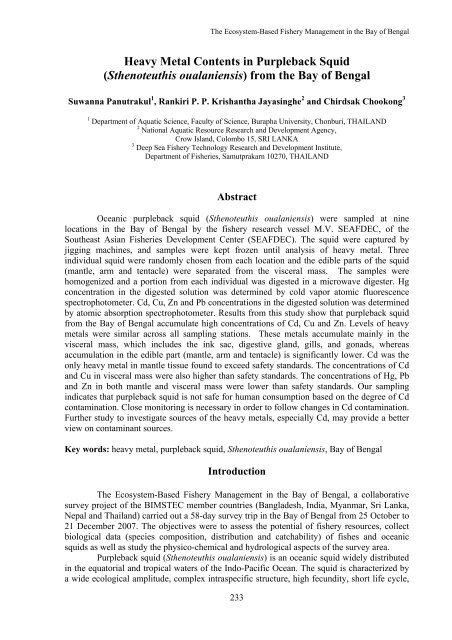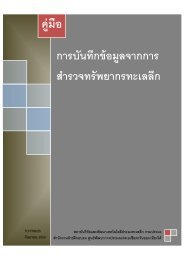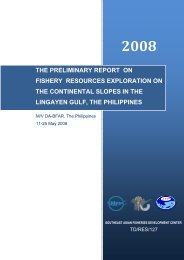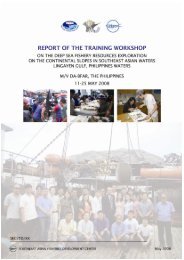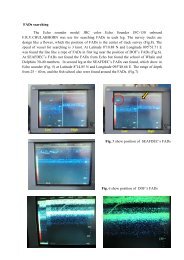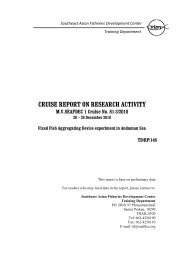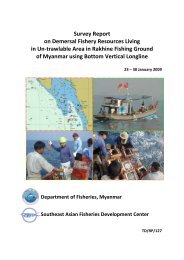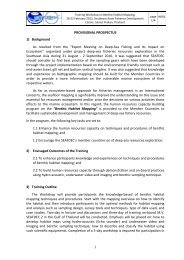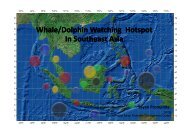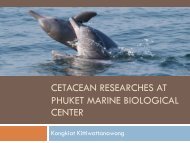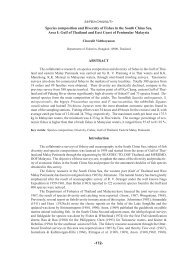Download - fisheries information system - Seafdec
Download - fisheries information system - Seafdec
Download - fisheries information system - Seafdec
You also want an ePaper? Increase the reach of your titles
YUMPU automatically turns print PDFs into web optimized ePapers that Google loves.
The Eco<strong>system</strong>-Based Fishery Management in the Bay of Bengal<br />
Heavy Metal Contents in Purpleback Squid<br />
(Sthenoteuthis oualaniensis) from the Bay of Bengal<br />
Suwanna Panutrakul 1 , Rankiri P. P. Krishantha Jayasinghe 2 and Chirdsak Chookong 3<br />
1 Department of Aquatic Science, Faculty of Science, Burapha University, Chonburi, THAILAND<br />
2 National Aquatic Resource Research and Development Agency,<br />
Crow Island, Colombo 15, SRI LANKA<br />
3 Deep Sea Fishery Technology Research and Development Institute,<br />
Department of Fisheries, Samutprakarn 10270, THAILAND<br />
Abstract<br />
Oceanic purpleback squid (Sthenoteuthis oualaniensis) were sampled at nine<br />
locations in the Bay of Bengal by the fishery research vessel M.V. SEAFDEC, of the<br />
Southeast Asian Fisheries Development Center (SEAFDEC). The squid were captured by<br />
jigging machines, and samples were kept frozen until analysis of heavy metal. Three<br />
individual squid were randomly chosen from each location and the edible parts of the squid<br />
(mantle, arm and tentacle) were separated from the visceral mass. The samples were<br />
homogenized and a portion from each individual was digested in a microwave digester. Hg<br />
concentration in the digested solution was determined by cold vapor atomic fluorescence<br />
spectrophotometer. Cd, Cu, Zn and Pb concentrations in the digested solution was determined<br />
by atomic absorption spectrophotometer. Results from this study show that purpleback squid<br />
from the Bay of Bengal accumulate high concentrations of Cd, Cu and Zn. Levels of heavy<br />
metals were similar across all sampling stations. These metals accumulate mainly in the<br />
visceral mass, which includes the ink sac, digestive gland, gills, and gonads, whereas<br />
accumulation in the edible part (mantle, arm and tentacle) is significantly lower. Cd was the<br />
only heavy metal in mantle tissue found to exceed safety standards. The concentrations of Cd<br />
and Cu in visceral mass were also higher than safety standards. The concentrations of Hg, Pb<br />
and Zn in both mantle and visceral mass were lower than safety standards. Our sampling<br />
indicates that purpleback squid is not safe for human consumption based on the degree of Cd<br />
contamination. Close monitoring is necessary in order to follow changes in Cd contamination.<br />
Further study to investigate sources of the heavy metals, especially Cd, may provide a better<br />
view on contaminant sources.<br />
Key words: heavy metal, purpleback squid, Sthenoteuthis oualaniensis, Bay of Bengal<br />
Introduction<br />
The Eco<strong>system</strong>-Based Fishery Management in the Bay of Bengal, a collaborative<br />
survey project of the BIMSTEC member countries (Bangladesh, India, Myanmar, Sri Lanka,<br />
Nepal and Thailand) carried out a 58-day survey trip in the Bay of Bengal from 25 October to<br />
21 December 2007. The objectives were to assess the potential of fishery resources, collect<br />
biological data (species composition, distribution and catchability) of fishes and oceanic<br />
squids as well as study the physico-chemical and hydrological aspects of the survey area.<br />
Purpleback squid (Sthenoteuthis oualaniensis) is an oceanic squid widely distributed<br />
in the equatorial and tropical waters of the Indo-Pacific Ocean. The squid is characterized by<br />
a wide ecological amplitude, complex intraspecific structure, high fecundity, short life cycle,<br />
233
The Eco<strong>system</strong>-Based Fishery Management in the Bay of Bengal<br />
high natural mortality, high growth rate and significant production (Nesis, 1977). It is very<br />
abundant and recognized as one of the main squid resources in the South China Sea and<br />
especially the northwestern Indian Ocean (Chesalin, 1997; Chesalin and Zuyev, 2002).<br />
Similar to all other squid, purpleback squid is carnivorous, feeding mainly on crustaceans,<br />
small fish, and other cephalopods (Collins et al., 1994; Collins and Pierce, 1996; Quetglas et<br />
al., 1999). Xinjun et al. (2007) found that stomach contents of purpleback squid from the<br />
northwestern Indian Ocean contained three major diet groups: fish, cephalopods and<br />
crustaceans, mainly Cypselurus spp. and S. oualaniensis. More than 60% of the stomachs of<br />
squid larger than 400 mm ML had evidence of cannibalism.<br />
Squid are themselves important prey items for large fish, sea birds, and marine<br />
mammals (Pierce and Santos, 1996; Santos et al., 2001). Squid (and other cephalopods) are<br />
very efficient accumulators of various trace elements (Martin and Flegal, 1975; Miramand<br />
and Bentley, 1992; Bustamante et al., 2002). Toxic metals such as cadmium and mercury are<br />
bioaccumulated and retained in squid (Bustamante et al., 1998, 2006) and consequently passed on<br />
to predators, thus potentially increasing the contaminant load in higher trophic levels,<br />
including humans (Bustamante et al., 1998; Lahaye et al., 2005; Storelli et al., 2005, 2006).<br />
The purpleback squid population in the Bay of Bengal has been recognized as a<br />
potential fishery resource for human consumption. Hence, <strong>information</strong> on heavy metal<br />
concentrations in this squid is important for future policy regarding exploitation of this<br />
species. The aims of this study were to determine and compare heavy metal concentrations in<br />
the edible portion (mantle, arm and tentacle) and visceral mass of purpleback squid<br />
(Sthenoteuthis oualaniensis) from nine sampling stations in the Bay of Bengal.<br />
Materials and Methods<br />
Samples of purpleback squid were caught by two Japanese automatic squid jigging<br />
machines which were fixed and operated at the starboard side of the fishery research vessel<br />
M.V. SEAFDEC, of the Southeast Asian Fisheries Development Center (SEAFDEC). The<br />
squid were attracted by 500 kilowatt light from 15 halogen lamps fixed along the starboard<br />
side of the ship at a height of 10 m from the surface of water. The lights were switched on 60<br />
minutes before the start of sampling. Collection occurred from 20.00-24.00 PM. for every<br />
sampling event. Seven of the sampling stations (1, 3, 7, 8, 9, 10 and 12) were located within<br />
area C, or the eastern part of the Bay of Bengal (Fig. 1). Two other sampling stations (14 and<br />
16) were located at the northern part of the Bay (area A; Fig. 1). A list of sampling stations<br />
and their positions can be found in Table 1.<br />
Mantle length and body weight of each individual caught were measured and<br />
recorded. Sex of the squids was determined by the presence or absence of a hectocotylus<br />
(modified ventral arm of the male). Each squid was placed in a plastic zip-log bag and kept<br />
frozen until analysis.<br />
Prior to heavy metal analysis the samples of purpleback squid were thawed at room<br />
temperature. Three individuals from each sampling station were randomly chosen for the<br />
analysis, except for station 3, in which only one squid was available. The edible body parts<br />
(mantle, arm and tentacle) and visceral mass of each squid were separated. The samples were<br />
cut and homogenized in a blender. A 1.0-1.5 g portion of each homogenized sample was<br />
carefully weighed in a Teflon vessel. Hydrogen peroxide and sub-boiled distilled nitric acid<br />
was added to the vessels. The vessels were then closed tightly and placed in a microwave<br />
digester (CEM; Mar5x). Afterwards, the samples were cooled down and diluted with<br />
deionized water. Mercury (Hg) concentration in the digested sample was determined by Cold<br />
Vapor Atomic Fluorescence Spectrometer (PSAnalytical; Merlin) whereas Cd, Pb, and Cu<br />
were determined by Graphite Furnace Atomic Absorption Spectrophotometer (Unicam;<br />
234
The Eco<strong>system</strong>-Based Fishery Management in the Bay of Bengal<br />
Solars). Zinc concentration was determined by Flame Atomic Absorption Spectrophotometer<br />
(Varian; SpectrAA-50).<br />
To validate the analytical technique, a certified reference material for trace metals,<br />
DORM-3 (National Research Council, Canada), was digested and heavy metal levels were<br />
determined in the same manner as for our samples. Limit of detection of each heavy metal<br />
was calculated from three standard deviations of eight method blanks.<br />
Figure 1 Map depicting the stations of automatic squid jigging in each area.<br />
Table 1 Dates of jigging operation, positions of sampling stations and depth of sampling stations.<br />
Area<br />
C<br />
A<br />
Jigggin<br />
operation<br />
no.<br />
Survey<br />
st. no.<br />
Date<br />
235<br />
Position Sea depth<br />
latitude (N) longitude (E)<br />
1 01 06/11/2007 10°18.20′ 95°01.00′ 2,628<br />
2 03 07/11/2007 10°14.40′ 96°32.80′ 538<br />
3 07 10/11/2007 11°04.90′ 95°36.30′ 513<br />
4 08 11/11/2007 11°54.50′ 95°06.70′ 2,884<br />
5 09 12/11/2007 11°45.60′ 96°32.40′ 883<br />
6 10 13/11/2007 12°04.50′ 96°23.40′ 1,128<br />
7 12 15/11/2007 12°29.50′ 94°54.50′ 1,418<br />
8 14 17/11/2007 16°49.50′ 90°20.90′ 2,353<br />
9 16 18/11/2007 18°01.40′ 90°35.70′ 2,136
The Eco<strong>system</strong>-Based Fishery Management in the Bay of Bengal<br />
Validity of Methods<br />
Results and Discussion<br />
Table 2 shows determined values, certified value and % recovery of Hg, Cd, Cu, Pb,<br />
and Zn of certified reference material (DORM-3; National Research Council, Canada) and<br />
limit of detection of each heavy metal. The recovery levels of all heavy metals from this study<br />
were within an acceptable range (96-103%).<br />
Table 2 Determined value, certified value and percent (%) recovery of heavy metal contents<br />
of the DORM-3 (n=4) as validation for analytical technique.<br />
Metals/description Hg (ug/g) Cd (ug/g) Cu (ug/g) Pb(ug/g) Zn (ug/g)<br />
Determined value 0.415±0.011 0.292±0.024 16.03±0.34 0.405±0.025 49.51±0.39<br />
Certified value 0.409 0.290 15.5 0.395 51.3<br />
% recovery 101.58±2.78 100.59±8.16 103.43±2.19 102.74±6.56 96.50±0.768<br />
Detection limit b 0.001 0.003 0.030 0.012 0.090<br />
Heavy Metal Contents in Squid<br />
Heavy metal concentrations in the edible portion (mantle, arm and tentacle) and<br />
visceral mass of purpleback squid (Sthenoteuthis oualaniensis) from each station in the Bay of<br />
Bengal are shown in table 3. Mean concentrations±standard deviation of Hg, Cd, Pb, Zn and<br />
Cu in the edible parts of purpleback squid from all sampling stations were 39.92±34.10<br />
(ng/g), 3.759±4.856, 0.035±0.029, 16.54±2.32 and 10.99±8.60 (µg/g), respectively. Mean<br />
concentrations ± standard deviation of Hg, Cd, Pb, Zn and Cu in the visceral mass of<br />
purpleback squid from all sampling stations were 34.26±25.32 (ng/g), 17.47±5.70,<br />
0.062±0.020, 43.82±9.86 and 73.68±47.07 (µg/g), respectively.<br />
Panutrakul (unpublished data) determined heavy metal concentrations in mantle<br />
tissue of marbled octopus (Octopus aegina) and pharaoh cuttlefish (Sepia pharaonis)<br />
collected from the upper Gulf of Thailand. For octopus, concentrations of Hg, Cd, Pb, Zn and<br />
Cu were 12.12±5.59 (ng/g), 0.020±0.037, 0.126±0.169, 19.88±4.42 and 11.48±5.10 (µg/g),<br />
respectively. For cuttlefish, concentrations of the same group of metals were 15.39±8.03<br />
(ng/g), 0.055±0.072, 0.061±0.029, 13.5±2.47, 5.76±1.69 (µg/g), respectively. Mean<br />
concentrations of Hg, Pb, Zn and Cu in edible tissue of purpleback squid from the Bay of<br />
Bengal were similar to concentrations found in octopus and cuttlefish in Thailand. However,<br />
Cd concentrations in purpleback squid were much higher than in the other two species.<br />
Pierce et al. (2008) measured Hg and Cd concentrations in tissues of two loliginid<br />
(Alloteuthis sp. and Loligo forbesi) and two ommastrephid (Todarodes sagittatus and<br />
Todaropsis eblanae) squid species collected in UK waters during 2004-2005. They found<br />
concentrations of Hg and Cd in muscle tissue of the squid to be in the range of 17-80 ng/g and<br />
0.021-0.256 µg/g, respectively. However, the authors also reported that the digestive gland is<br />
the main storage organ of Cd in these squid species. Hg and Cd concentrations in the<br />
digestive gland of these squid varied from 17-110 (ng/g) and 0.16-3.31 (µg/g), respectively.<br />
In comparing results from this study with those of Pierce et al. (2008) we found that squid<br />
from UK waters show slightly higher Hg concentration in both muscle and digestive gland<br />
than our samples from the Bay of Bengal. Meanwhile, Cd concentrations in both muscle and<br />
digestive gland of squid from UK waters were lower than our samples.<br />
236
The Eco<strong>system</strong>-Based Fishery Management in the Bay of Bengal<br />
Bioconcentration and bioaccumulation experiments of Cd by oval squid (Sepioteuthis<br />
lessoniana) run by Koyama et al. (2000) showed that oval squid can take Cd up via diffusion<br />
of Cd ions from the water and from their diet. After 14 days of exposure to 0.2 mg Cd/l<br />
seawater, the mean Cd concentrations in the liver, gill, digestive tract, mantle, ink sac and the<br />
remaining parts of the squid were 49.3, 19.2, 7.08, 0.79, 1.35 and 1.62 µg/g wet weight,<br />
respectively. In another experiment, squid were reared in 0.12 mg Cd/l seawater, and also fed<br />
a diet of fish raised in the same seawater. The mean Cd concentrations in the liver, gill,<br />
digestive tract, mantle, ink sac and remaining parts of the squid were 58.8, 19.4, 13.0, 1.10,<br />
3.30 and 1.13 µg/g wet weight, respectively. Their results showed that oval squid can<br />
bioconcentrate and bioaccumulate waterborne and dietary Cd in a short period of time. Cd<br />
tends to accumulate primarily in liver whereas Cd concentration in the mantle is lower than in<br />
the other tissues.<br />
Figure 2 Box plot of heavy metal concentrations in edible parts (mantle, arm and tentacle)<br />
and visceral mass of purpleback squid (Sthenoteuthis oualaniensis) collected from<br />
the Bay of Bengal.<br />
237
The Eco<strong>system</strong>-Based Fishery Management in the Bay of Bengal<br />
Table 3 Heavy metal concentrations in edible body parts (mantle, arm and tentacle) and visceral mass of purpleback squid (Sthenoteuthis<br />
oualaniensis) collected from the Bay of Bengal.<br />
238
238<br />
239<br />
The Eco<strong>system</strong>-Based Fishery Management in the Bay of Bengal<br />
Table 3 Heavy metal concentrations in edible body parts (mantle, arm and tentacle) and visceral mass of purpleback squid (Sthenoteuthis<br />
oualaniensis) collected from the Bay of Bengal.<br />
Station<br />
Hg (ng/g) Cd (µg/g) Pb (µg/g) Zn (µg/g) Cu (µg/g)<br />
Body Visceral Body Visceral Body Visceral Body Visceral Body Visceral<br />
1 30.58±6.66 54.09±67.66 1.975±0.095 23.136±2.345 0.028±0.009 0.046±0.005 15.92±0.43 55.74±11.76 8.28±5.54 66.12±17.63<br />
3 24.77 33.50 2.336 14.186 0.023 0.073 14.27 31.46 5.54 21.97<br />
7 80.07±34.06 45.74±11.59 2.980±1.999 14.87±4.36 0.018±0.002 0.061±0.026 14.85±2.13 42.84±7.29 7.76±3.12 94.15±39.42<br />
8 56.9±48.75 35.31±14.32 2.570±0.326 22.44±4.92 0.021±0.004 0.062±0.013 15.19±1.87 34.93±6.50 6.65±0.70 57.21±16.24<br />
9 60.17±65.31 44.19±29.00 1.348±0.686 14.78±2.81 0.024±0.017 0.057±0.014 15.27±1.336 42.46±12.41 12.17±11.26 89.21±100.76<br />
10 18.82±12.36 20.69±5.70 1.180±0.332 12.02±1.95 0.046±0.019 0.058±0.019 16.15±0.049 35.04±3.61 5.77±0.37 49.99±24.76<br />
12 18.90±18.58 25.59±11.62 1.865±0.413 20.13±5.57 0.045±0.040 0.042±0.013 16.48±1.57 52.78±4.80 10.54±5.97 60.63±20.32<br />
14 24.99±13.42 21.44±7.01 4.117±1.410 20.01±7.52 0.084±0.080 0.082±0.025 19.86±1.10 45.98±6.33 15.35±4.50 77.80±17.12<br />
16 33.96±0.90 27.32±8.53 14.511±8.347 13.45±6.46 0.031±0.018 0.085±0.007 19.35±3.12 44.87±6.78 23.23±17.95 111.60±83.01<br />
The Eco<strong>system</strong>-Based Fishery Management in the Bay of Bengal
The Eco<strong>system</strong>-Based Fishery Management in the Bay of Bengal<br />
Differences in Heavy Metal Concentrations between Body Parts and among Sampling<br />
Location<br />
Two-way analysis of variance was used to test the effects of body part and sampling<br />
station on Hg, Cd, Pb, Zn and Cu concentrations of purpleback squid (Table 4). Body part and<br />
sampling location were significant factors for Cd, and Zn concentrations. Cd concentration in<br />
visceral mass of squid in every station, except station 16, was significantly higher (p
The Eco<strong>system</strong>-Based Fishery Management in the Bay of Bengal<br />
heavy metals are reported based on dry weight whereas results from this work is based on wet<br />
weight).<br />
Hence, results from this study and those previously reported suggest that internal<br />
organs, especially digestive gland and liver, are the main storage organs for most heavy<br />
metals. Cd, Cu and Zn are the three metals that have been found highly accumulated in<br />
digestive gland and liver of cephalopods. The high contamination levels of Cd, Cu and Zn<br />
found in Japanese common squid waste (Omid and Hiroyuki, 2005) resulted from highly<br />
contaminated visceral mass which is the major component of squid waste.<br />
Sources of Cd and Other Metals Residue in Squid<br />
It has long been recognized that squid and other cephalopods can accumulate high<br />
levels of cadmium and other metals. Squid also play a major role in transferring these metals<br />
through the food chain (Martin & Flegal, 1975; Smith et al. 1984; Miramand & Guary 1980;<br />
Finger & Smith 1987; Miramand & Bentley 1992; Bustamante 1998; and Bustamante et al.,<br />
1998a). However, the sources of Cd and other metal residues in squid and other cephalopods<br />
has never been clear. Squid and most other cephalopods are characterized by high growth<br />
rate, high mortality rate, high fecundity and short life. Xinjun et al. (2007) reported that most<br />
purpleback squid from the northwestern Indian Ocean have a life span of 0.5-1.0 year. Thus,<br />
high levels of heavy metals in these organisms are not a result of long term accumulation.<br />
Koyama et al. (2000) concluded from their experimental work that accumulation of<br />
Cd in oval squid (Sepioteuthis lessoniana) can occur via diffusion from seawater into the<br />
body and by ingestion. Xinjun et al. (2007) found that stomach contents of purpleback squid<br />
from the northwestern Indian Ocean contained three major diet groups: fish, cephalopods and<br />
crustaceans, mainly Cypselurus spp. and S. oualaniensis. More than 60% of the stomachs had<br />
evidence of cannibalism for the squid larger than 400 mm ML.<br />
Data on dissolved heavy metals in the Bay of Bengal are rare. Therefore, it is<br />
difficult to make any conclusion on the sources of the heavy metals in purpleback squid.<br />
Since purpleback squid is carnivorous and even cannibalistic (Xinjun et al. 2007), it appears<br />
that residues of these heavy metals come at least in part via ingestion.<br />
Table 5 Cd, Cu and Zn concentrations (μg/g dry wt) determined in the digestive gland of<br />
cephalopods from the literature.<br />
Species Cd Cu Zn Authors<br />
Sepia officinalis 12.67±0.35 315±3 571±47 Miramand & Bentley (1992)<br />
Loligo opalescens 85.0±51.6 5350±3210 247±131 Martin & Flegal (1975)<br />
L. opalescens 121.5±57.9 8370±3130 449±201 "<br />
N. gouldi 50±25 246±298 696±295 Smith et al. (1984)<br />
Ommastrephes bartrami 287±202 195±212 163±55 Martin & Flegal (1975)<br />
Stenoteuthis oualaniensis 782±255 1720±151 513±288 "<br />
Eledone cirrhosa 24.00±1.75 456 ±11 646±86 Miramand & Bentley (1992)<br />
Benthoctopus thielei 215 42 416 Bustamante et al. (1998a)<br />
Graneledone sp. 369 1092 102 Bustamante et al. (1998a)<br />
Octopus vulgaris 2550 Ghiretti-Magaldi et al. (1958)<br />
O. vulgaris 50±10 2500±700 1450±400 Miramand & Guary (1980)<br />
241
The Eco<strong>system</strong>-Based Fishery Management in the Bay of Bengal<br />
Safety Issues for Human Consumption<br />
Table 6 compares the mean concentration of heavy metals of squid with the safety limits<br />
from several countries. The Hg, Pb and Zn concentrations in both edible tissue and visceral mass<br />
were within the safety limits at every sampling station. Mean Cu concentration in visceral mass<br />
of squid were higher than the safety limits, whereas concentrations in the edible portion were<br />
below the safety limit. Mean Cd concentration in both edible tissue and visceral mass of the squid<br />
exceeded all of the proposed safety limits at every sampling station. Cadmium concentrations in<br />
visceral mass were in fact many times higher than the safety standards. Therefore, due to Cd<br />
contamination, purpleback squid from the Bay of Bengal may not be a proper food source for<br />
humans.<br />
Conclusion<br />
Results from this study show that purpleback squid (Sthenoteuthis oualaniensis), an<br />
oceanic squid widely distributed in the Indian Ocean and the Bay of Bengal, accumulate high<br />
concentrations of Cd, Cu and Zn. The levels of heavy metals in the squid from all sampling<br />
stations were within the same range. Accumulation of these metals takes part mainly in<br />
visceral mass which contains the digestive gland, gill, and gonad, whereas accumulation in<br />
the edible portion (mantle, arm and tentacle) is lower. The concentration of Hg, Pb and Zn in<br />
both edible tissue and visceral mass were lower than safety standards. The concentration of<br />
Cd and Cu in visceral mass were higher than the safety standard. Cd was the only heavy metal<br />
found in mantle tissue to exceed safety standards, and is thus the most immediate concern for<br />
human consumption of purpleback squid. Close monitoring is necessary to follow changes of<br />
contamination levels. Further investigation may also provide a better view of contaminant<br />
sources, particularly for cadmium.<br />
Table 6 Mean concentrations (µg g -1 ) of heavy metals found in the edible portion (mantle,<br />
arm and tentacle) and visceral mass of purpleback squid (Sthenoteuthis<br />
oualaniensis) from all sampling stations in the Bay of Bengal and recommended<br />
safety limits. 1-5<br />
Heavy metals Edible part Visceral mass Safety limit (µg/g) References<br />
Hg 0.040±0.034 0.034±0.025 0.5 1, 2<br />
Cd 3.759±4.856* 17.47±5.70* 2, 3, 0.5 1, 3, 4<br />
Pb 0.035±0.029 0.062±0.020 0.5, 1.5, 0.5 2, 3, 5<br />
Zn 16.54±2.32 43.82±9.86 ≤100 2<br />
Cu 10.99±8.60 73.68±47.07* ≤20 2<br />
1 Australia and New Zealand Food Authority Amendment No. 53. (2000).<br />
2<br />
Minsitry of Public Health, Thailand (1986).<br />
3<br />
US Food and Drug Administration (2001).<br />
4<br />
FAO. Report of the Codex Committee on Food Additives and Contaminants. Draft Guideline level for<br />
Cadmium in Food (http://www.fao.org/docrep/meeting/005/x7137e/x7137e20.htm)<br />
5<br />
FAO. Report of the Codex Committee on Food Additives and Contaminants. Draft Maximum level for Lead<br />
(http://www.fao.org/docrep/meeting/005/x7137e/x7137e1z.htm#TopOfPage)<br />
*indicates maximum concentration was higher than safety limit for at least one of the agencies listed.<br />
242
The Eco<strong>system</strong>-Based Fishery Management in the Bay of Bengal<br />
References<br />
Australia and New Zealand Food Authority. 2000. Provisional Regulation Limitation of<br />
Contamination in Food, Specifications and Standards for Foods, Food Additives, etc.<br />
Under The Food Sanitation Laws, April 2004, Standard 1.4.1, Contamination and<br />
Natural Toxicants, Maximum level of metal contaminates in food, Australia and<br />
New Zealand Food Authority Amendment no.53 to Food Standard Code,<br />
Commonwealth of Australia, 2000.<br />
Bustamante, P., F. Caurant, S. W. Fowler and P. Miramand. 1998. Cephalopods as a vector<br />
for the transfer of cadmium to top marine predators in the north-east Atlantic Ocean.<br />
Sci. Total Environ. 220:71-80.<br />
Bustamante, P., J. L. Teyssie, S. W. Fowler, O. Cotret, B. Danis, P. Miramand and M. Warnau.<br />
2002. Biokinetics of zinc and cadmium accumulation and depuration at different<br />
stages in the life cycle of the cuttlefish Sepia officinalis. Mar. Ecol. Prog. Ser.<br />
231:167-177.<br />
Bustamante, P., V. Lahaye, C. Durnez, C. Churlaud and F. Caurant. 2006. Total and organic<br />
Hg concentrations in cephalopods from the North East Atlantic waters: influence of<br />
geographical origin and feeding ecology. Sci. Total Environ. 368:585-596.<br />
Chesalin, M. V. 1994. Distribution and biology of the squid Sthenoteuthis oualaniensis in<br />
the Arabian Sea. Hydrobiol. J. 30(2):61-73.<br />
Chesalin, M. V. and G. V. Zuyev. 2002. Pelagic cephalopods of the Arabian Sea with an<br />
emphasis on Sthenoteuthis oualaniensis. Bull. Mar. Sci. 71(1):209-221.<br />
Collins, M. A. and G. J. Pierce. 1996. Size selectivity in the diet of Loligo forbesi<br />
(Cephalopoda: Loliginidae). J. Mar. Biol. Assoc. UK. 76:1081-1090.<br />
FAO. Report of the Codex Committee on Food Additives and Contaminants. Draft Guideline level<br />
for Cadmium in Food . Available Source:<br />
http://www.fao.org/docrep/meeting/005/x7137e/x7137e20.htm.<br />
FAO. Report of the Codex Committee on Food Additives and Contaminants. Draft Maximum level<br />
for Lead. Available Source:<br />
http://www.fao.org/docrep/meeting/005/x7137e/x7137e1z.htm.<br />
FAO/WHO Codex Alimentarius Commission. 2005. Codex General Standard for<br />
Contaminants and Toxins in Food. Schedule 1. Maximum and Guideline Levels for<br />
Contaminants and Toxins in Food.<br />
Ghiretti-Magaldi, A., A. Giuditta and F. Ghiretti. 1958. Pathways of terminal respiration in<br />
marine invertebrates. I. The respiratory <strong>system</strong> in cephalopods. J. Cell. Comp.<br />
Physiol. 52:389-429.<br />
Koyama, J., N. Nanamori and S. Segawa. 2000. Bioaccumulation of waterborne and dietary<br />
Cadmium by Oval Squid, Sepioteuthis lessoniana and its distribution among organs.<br />
Marine Pollution Bulletin 40:961-967.<br />
Lahaye, V., P. Bustamante, J. Spitz, K. Das, L. Meynier, V. Magnin, W. Dabin and F. Caurant.<br />
2005. Long-term dietary preferences of common dolphins in the Bay of Biscay<br />
using a metallic tracer. Mar. Ecol. Prog. Ser. 305:275-285.<br />
Martin, J. H. and A. R. Flegal. 1975. High copper concentrations in squid livers in<br />
association with elevated levels of silver, cadmium, and zinc. Mar. Biol. 30:51-55.<br />
Ministry of Public Health. 1986. Notification No. 98. Standard Contamination Level in<br />
Food. Ministry of Public Health, Thailand.<br />
Miramand, P. and D. Bentley. 1992. Concentration and distribution of heavy metals in<br />
tissues of two cephalopods, Eledone cirrhosa and Sepia officinalis, from the French<br />
coast of the English Channel. Mar. Biol. 114:407-414.<br />
243
The Eco<strong>system</strong>-Based Fishery Management in the Bay of Bengal<br />
Miramand, P. and J. C. Guary. 1980. High concentrations of some heavy metals in tissues of<br />
the Mediterranean octopus. Bull. Environ. Contam. Toxicol. 24:783-788.<br />
Nesis, K. N. 1977. Population structure in the squid Sthenoteuthis oualanienses (Lessonn 1930)<br />
(Ommastrephidae) in theWestern Tropical Pacific. In: Proceedings of the Academy<br />
of Science USSR, Shirsch Inst. Oceanol. 107:15-29.<br />
Omid, T. and Y. Hiroyuki. 2005. Effective recovery of harmful metal ions from squid waste<br />
using subcritical and supercritical water treatment. Environmental Science and<br />
Technology 39:2357-2363.<br />
Panutrakul, S. (unpublished data). Heavy metal in Octopus and Cuttlefish from the Upper<br />
Gulf of Thailand.<br />
Pierce, G. J. and M. B. Santos. 1996. Trophic interactions of squid Loligo forbesi in Scottish<br />
waters. In: Greenstreet, S. P. R. and M. L. Tasker. (eds.). Aquatic Predators and<br />
their Prey. Fishing News Books, Oxford. p. 58-64.<br />
Pierce, G. J., G. Stowasser, L. C. Hastie and P. Bustamante. 2008. Geographic, seasonal and<br />
ontogenetic variation in cadmium and mercury concentrations in squid<br />
(Cephalopoda: Teuthoidea) from UK waters. Ecotoxicology and Environmental<br />
Safety 70:422-432.<br />
Quetglas, A., F. Alemany, A. Carbonell, P. Merella and P. Sanchez. 1999. Diet of the<br />
European flying squid Todarodes sagittatus (Cephalopoda: Ommastrephidae) in the<br />
Balearic Sea (western Mediterranean). J. Mar. Biol. Assoc. UK. 79:479-486.<br />
Santos, M. B., G. J. Pierce, J. Herman, A. Lopez, A. Guerra, E. Mente and M. R. Clarke.<br />
2001. Feeding ecology of Cuvier’s beaked whale (Ziphius cavirostris): a review with<br />
new <strong>information</strong> on the diet of this species. J. Mar. Biol. Assoc. UK. 81:687-694.<br />
Seixas, S., P. Bustamante and G. Pierce. 2005. Accumulation of mercury in the tissues of the<br />
common octopus Octopus vulgaris (L.) in two localities on the Portuguese coast.<br />
Science of the Total Environment 340:113-122.<br />
Smith, J. D., L. Plues, M. Heyraud and R. D. Cherry. 1984. Concentrations of the elements<br />
Ag, Al, Ca, Cd, Cu, Fe, Mg, Pb and Zn, and the radionuclides 210Pb and 210Po in the<br />
digestive gland of the squid Nototodarus gouldi. Mar. Environ. Res. 13:55-68.<br />
Storelli, M. M., G. Barone and G. O. Marcotrigiano. 2005. Cadmium in cephalopod<br />
molluscs: implications for public health. J. Food Prot. 68:577-580.<br />
Storelli, M. M., R. Giacominelli-Stuffler, A. Storelli and G. O. Marcotrigiano. 2006.<br />
Cadmium and mercury in cephalopod molluscs: estimated weekly intake. Food<br />
Addit. Contam. 23:25-30.<br />
US. Food and Drug Administration. 2001. Fish and Fisheries Products Hazards and Controls<br />
Guidance. 3 rd edition. Appendix 5. FDA & EPA Safety Levels in Regulations and<br />
Guidance. Available Source: http://vm.cfsan.fda.gov/~comm/haccp4x5.html.<br />
Xinjun, C., C. Bilin, T. Siquan, Q. Weiguo and Z. Xiaohu. 2007. Fishery biology of<br />
purpleback squid, Sthenoteuthis oualaniensis, in the northwest Indian Ocean.<br />
Fisheries Research 83:98-104.<br />
244


